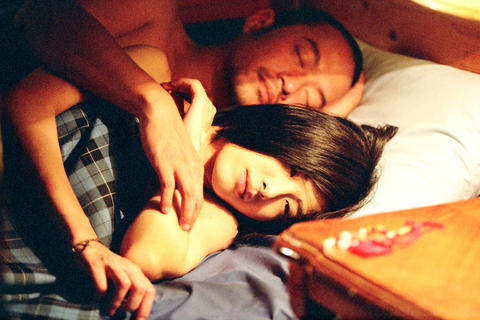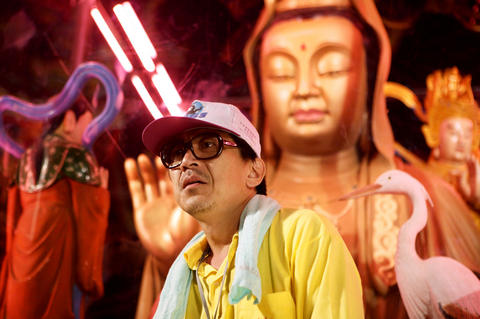Eight years after her critically acclaimed debut Bundled (我叫阿銘啦), director Singing Chen (陳芯宜) returns with her second feature, God Man Dog (流浪神狗人), an allegorical tale of contemporary Taiwan told through a mosaic of characters.
Blessed with a strong cast and production department, the film threads slices of Taiwanese life together with dreamlike visuals that linger in the mind long after the movie ends. God Man Dog has been well-received on the international film festival circuit and should also appeal to local audiences. It proves Chen, 34, is a promising, shining star among the younger generation of Taiwanese filmmakers.
The film follows the lives of characters from different ethnic groups, religious backgrounds and socioeconomic strata. It begins with Ching (Tarcy Su), a model suffering from postnatal depression who becomes increasingly estranged from her architect husband Hsiung (Chang Han) after their baby's death.

PHOTO: COURTESY OF 3RD VISION FILMS
Meanwhile, Aborigine Biung (Ulau Ugan) ekes out a living delivering fruit while attempting to cope with his alcoholism. His teenage daughter Savi (Tu Hsiao-han) escapes by becoming a kick boxer in Taipei and returns with expensive gifts after a friend enlists her in a scheme to steal money from the clients of a BDSM call-girl service.
In the third storyline, Yellow Bull (Jack Kao) drives a truck loaded with statues of deities who have been abandoned by their followers for not answering their prayers. Yellow Bull feeds stray dogs and takes in young drifter named Hsien, played by Jonathan Chang from Edward Yang's (楊德昌) Yi-Yi (一一), even though he hardly has enough money to replace his worn artificial leg. A car accident caused by a stray dog brings the three narratives together.
God Man Dog is technically accomplished and eloquently scripted. The film shows Chen as a surprisingly mature filmmaker who is able to look at the vices and virtues of Taiwanese society while telling an arresting story in a distinct style. It is an ambitious work that touches many issues, including the commodification of the body, the social problems faced by Taiwan's Aborigines, the anomie of city-dwellers, and the confused values of the young. Everything is tied together under a coherent structure by smooth editing and crosscutting between multiple characters and plot lines.

PHOTO: COURTESY OF 3RD VISION FILMS
Taiwan's collage of cultures finds a colorful epitome in Chen's vision, punctuated by the eerie sounds of a musical saw and cello by choreographer Sakamoto Hiromichi, of Hiroshima, Japan. Shen Ko-shang's (沈可尚) dynamic cinematography and atmospheric art direction by Huang Mei-ching (黃美清) help to fashion this visually imaginative film with a nod to magical realism: human-sized god puppets dancing in a deserted building, a neon-lit truck full of Buddhas wending its way through mountains under a dark sky.
On a narrative level, tragedy mixes with comedy. Storylines revolve around the film's central motif: how things are assigned value in Taiwanese society. "I reveal changing manmade values through items and things," Chen said. "Take the peach, for example. It is an expensive luxury in the eyes of Biung and his wife. In the film studio, it is merely something that can be consumed. But to Yellow Bull and Hsien, a peach is just a fruit to fill the stomach."
God Man Dog is laden with symbolism, but it is equally enjoyable for the entertainment seeker, with plenty of humorous moments of the kind that are rarely found in local productions. The most memorable of these come from the electrifying onscreen chemistry between veteran actor Kao and young Jonathan Chang. Kao shines in this film, breathing life into his Everyman role with a seemingly effortless, understated performance. Chang's equally eye-catching work suggests a star in the making. Pop idol-turned-serious actress Tarcy Su also turns in a convincing performance, although the plotline following the affluent urban couple is the film's weakest segment.

PHOTO: COURTESY OF 3RD VISION FILMS

Following the rollercoaster ride of 2025, next year is already shaping up to be dramatic. The ongoing constitutional crises and the nine-in-one local elections are already dominating the landscape. The constitutional crises are the ones to lose sleep over. Though much business is still being conducted, crucial items such as next year’s budget, civil servant pensions and the proposed eight-year NT$1.25 trillion (approx US$40 billion) special defense budget are still being contested. There are, however, two glimmers of hope. One is that the legally contested move by five of the eight grand justices on the Constitutional Court’s ad hoc move

Stepping off the busy through-road at Yongan Market Station, lights flashing, horns honking, I turn down a small side street and into the warm embrace of my favorite hole-in-the-wall gem, the Hoi An Banh Mi shop (越南會安麵包), red flags and yellow lanterns waving outside. “Little sister, we were wondering where you’ve been, we haven’t seen you in ages!” the owners call out with a smile. It’s been seven days. The restaurant is run by Huang Jin-chuan (黃錦泉), who is married to a local, and her little sister Eva, who helps out on weekends, having also moved to New Taipei

The Directorate-General of Budget, Accounting and Statistics (DGBAS) told legislators last week that because the Chinese Nationalist Party (KMT) and Taiwan People’s Party (TPP) are continuing to block next year’s budget from passing, the nation could lose 1.5 percent of its GDP growth next year. According to the DGBAS report, officials presented to the legislature, the 2026 budget proposal includes NT$299.2 billion in funding for new projects and funding increases for various government functions. This funding only becomes available when the legislature approves it. The DGBAS estimates that every NT$10 billion in government money not spent shaves 0.05 percent off

Dec. 29 to Jan. 4 Like the Taoist Baode Temple (保德宮) featured in last week’s column, there’s little at first glance to suggest that Taipei’s Independence Presbyterian Church in Xinbeitou (自立長老會新北投教會) has Indigenous roots. One hint is a small sign on the facade reading “Ketagalan Presbyterian Mission Association” — Ketagalan being an collective term for the Pingpu (plains Indigenous) groups who once inhabited much of northern Taiwan. Inside, a display on the back wall introduces the congregation’s founder Pan Shui-tu (潘水土), a member of the Pingpu settlement of Kipatauw, and provides information about the Ketagalan and their early involvement with Christianity. Most